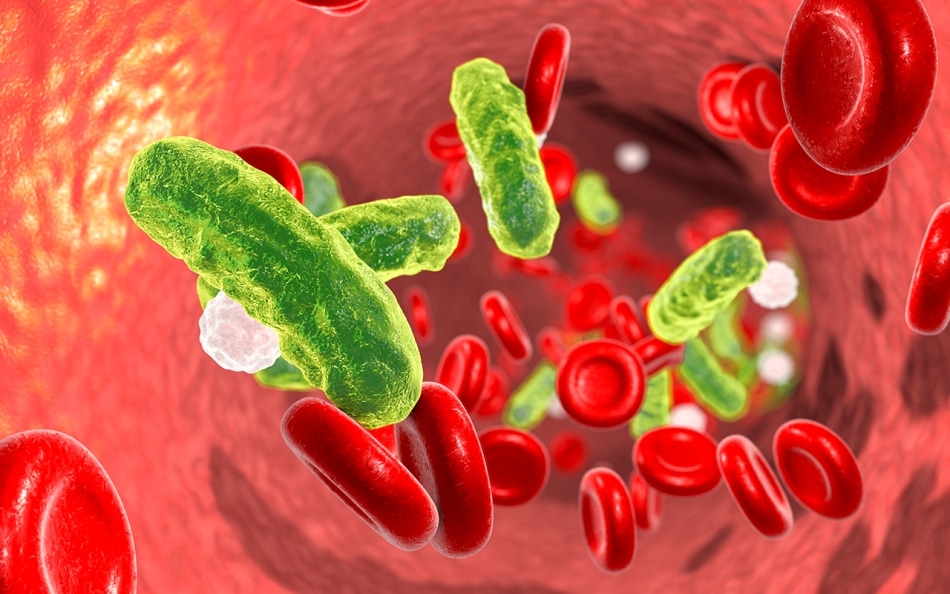Jan 8 2018
A research team at the University of California San Diego has created macrophage “nanosponges”, capable of safely absorbing and removing molecules from the bloodstream identified for triggering sepsis. These macrophage nanosponges, referring to nanoparticles cloaked in the cell membranes of macrophages, have so far enhanced survival rates in mice with sepsis.
 Photo credit: iStock Photo/Dr_Microbe
Photo credit: iStock Photo/Dr_Microbe
This work is an example of the cell membrane cloaking technology established by the lab of Liangfang Zhang, a professor of nanoengineering at the UC San Diego Jacobs School of Engineering. His group focuses on developing new nanomedicine therapies by camouflaging nanoparticles as the body’s own cells. Earlier examples include nanoparticles covered in platelet cell membranes for repairing wounded blood vessels; red blood cell nanosponges to combat and then prevent MRSA infections; and nanofibers cloaked in beta cell membranes capable of being used to help diabetes patients produce more insulin.
In the present study, Zhang’s lab developed macrophage nanosponges that provide a favorable solution for efficiently treating and then managing sepsis. Zhang’s lab partnered with Victor Nizet, a professor of pediatrics and pharmacy at UC San Diego, whose team assisted in testing the macrophage nanosponges in vivo.
Sepsis occurs when the body introduces an uncontrolled immune response to an infection, activating widespread inflammation that can result in septic shock, organ failure and even death. The U.S. Centers for Disease Control and Prevention estimate that over 1.5 million Americans get sepsis and almost 250,000 die because of this condition every year.
Sepsis is generally treated with antibiotics. However, while antibiotics can possibly abolish sepsis-causing bacteria, they cannot keep inflammation in check.
Some sepsis-causing bacteria secrete toxic molecules known as endotoxins. Macrophages — white blood cells that play a vital role in inflammation — identify endotoxins as dangerous. In response, macrophages generate inflammation-causing proteins known as pro-inflammatory cytokines, which in turn trigger other macrophages to generate more cytokines, establishing a dangerous domino effect of inflammation all over the body.
“To effectively manage sepsis, you need to manage this cytokine storm,” said Zhang.
In a paper featured in Proceedings of the National Academy of Sciences, Zhang and a team of researchers at UC San Diego demonstrated that macrophage nanosponges are capable of safely neutralizing both pro-inflammatory cytokines and endotoxins in the bloodstream.
An extensive range of pro-inflammatory cytokines and endotoxins naturally bind to macrophage cell membranes, meaning that these nanosponges aid as universal traps for a broad spectrum of sepsis-causing molecules, Zhang explained. “They can work across different bacterial genus, species and strains,” he said. Furthermore, since they are covered in real macrophage cell membranes, they will be able to pass as the body’s own immune cells and then circulate the bloodstream without being expelled.
Researchers made use of macrophage cells from mice to develop the nanosponges. The cells were soaked in a solution that allowed the cells burst, leaving behind the membranes. The membranes were then collected with the help of a centrifuge, followed by mixing them with ball-shaped nanoparticles produced from biodegradable polymer. The nanoparticles were spontaneously coated in macrophage cell membranes by the mixing step.
The team directed the macrophage nanosponges to a group of mice infected with a lethal dose of E. coli. The treatment enables keeping four out of 10 mice in this group alive, while all mice in the untreated group died. One dose of the macrophage nanosponges majorly reduced the levels of pro-inflammatory cytokines and endotoxins in the treated mice. This prevented systemic inflammation and also decreased the bacterial count in the spleen and blood of these mice.
Zhang is currently working with biopharmaceutical companies in order to translate the macrophage nanosponges into clinical use. Next steps will involve manufacturing the nanosponges in huge scales and then performing large animal trials.
This work has been supported by the National Science Foundation (grant DMR-1505699), the Defense Threat Reduction Agency Joint Science and Technology Office for Chemical and Biological Defense (grant HDTRA1-14-1-0064) and the National Institutes of Health (grant 1R01HL125352).
Paper title: “Macrophage-like nanoparticles concurrently absorbing endotoxins and proinflammatory cytokines for sepsis management.” Authors of the study are Soracha Thamphiwatana*, Pavimol Angsantikul*, Tamara Escajadillo*, Qiangzhe Zhang, Joshua Olson, Brian T. Luk, Sophia Zhang, Ronnie H. Fang, Weiwei Gao, Victor Nizet and Liangfang Zhang at UC San Diego.
*These authors equally contributed to this work.